Solar radiation drives almost every dynamic process on the Earth’s surface and above, from ocean current circulation to the weather, and life itself. Precise long-term measurements of the radiation budget at the surface are fundamental to understanding the Earth’s climate system. Rising fossil fuel costs and the need to reduce Carbon footprints has produced a rapid growth in the market for "green" energy, in which the fastest growing sector is solar power.
Scientists, researchers and commercial companies in renewable energy, climatology, weather, agriculture, water resources and environment all require accurate and reliable measurements of solar radiation. The measurement is made by pyranometers, which are radiometers designed for measuring the total (global) irradiance on a plane surface resulting from radiant fluxes in the wavelength range from 300 nanometers (nm),or less, to 3000 nm.
Kipp & Zonen has been manufacturing pyranometers for over 85 years. We produce models at all price and performance points, up to the very best available. All comply with the requirements of ISO 9060:1990 and are fully traceable to the World Radiometric Reference (WRR) in Davos, Switzerland, where Kipp & Zonen instruments form part of the World Standard Group.
Our top level pyranometers have exceptional levelling accuracy, built-in temperature sensors and a test certificate with individually measured directional and temperature responses. These important features ensure the highest accuracy measurements. Kipp & Zonen pyranometers are designed for a long operating life with simple maintenance and a wide range of accessories is available.
| Applications | |||
| Kipp & Zonen pyranometers have been developed to be suitable for use in all environments, from the Antarctic to deserts. They are installed around the world for meteorology, hydrology, climate research, solar energy, environmental and materials testing, greenhouse control, building automation and many other applications. The CMP10 is specially designed for applications where regular visits and maintenance is difficult. A dedicated brochure is available for the CM 4, for use in climate chambers up to 150°C. | |||
| Choix du pyranomètre | |||
| To achieve the required spectral and directional characteristics CMP Series pyranometers use thermopile detectors and glass or quartz domes. All models have built-in bubble levels and adjustable levelling feet. The waterproof connectors have gold-plated contacts and are fitted with 10 m of high quality signal cable as standard. The instruments do not require power and are supplied with comprehensive calibration certificates. The most appropriate model for an application largely depends on the desired accuracy and performance. | |||
| Description | ||||
| CMP 3 is smaller and lighter than the other CMP Series pyranometers. It has a robust 4 mm thick glass dome to protect the thermopile from external influences. The small size and sealed construction make this instrument the ideal choice for horticulture, monitoring solar energy installations, industrial applications, and it can be used underwater. A screw-in mounting rod is available for easy installation. CMP 6 has a similar detector to CMP 3, but has improved performance due to the increased thermal mass and the double glass dome construction. It is recommended for cost-eective, good quality, measurements in meteorological and hydrological networks and agriculture. CMP10 is the secondary standard pyranometer with the best price-quality-performance ratio on the market. With the same specifications and detector as CMP 11, CMP10 extends this quality to applications where maintenance is difficult and/or forms a major part of the cost of ownership. The CMP10 has internal desiccant that lasts for at least 10 years. This minimizes maintenance significantly. The interval for dome cleaning can be extended, and the quality of measurements maximized, by adding the CVF4 ventilation unit. Kipp & Zonen provides every CMP10 with a 5-year warranty as standard. This warranty applies provided that the CMP10 is used only under atmospheric conditions, that the housing is not opened and that the Kipp & Zonen cable and connector is correctly fitted. The internal desiccant is changed with every factory re-calibration. CMP 11 uses a temperature compensated detector. It is a step up in performance from CMP 6 and particularly suitable for upgrading meteorological networks. The faster response time meets the requirements for solar energy research and development applications. CMP 11 is also ideal for use in sun tracker based solar monitoring stations. |  | |||
| CMP 21 is similar to CMP 11 but has individually optimised temperature compensation. A standard thermistor sensor is fitted to monitor the housing temperature. Each instrument is supplied with its own temperature and directional (cosine) response data. It is the choice for scientific use and in top level solar radiation monitoring networks such as the Baseline Surface Radiation Network (BSRN) of the World Meteorological Organisation. CMP 22 has all the features of CMP 21 but uses very high quality quartz domes for a wider spectral range, improved directional response, and reduced thermal osets. Because of the high optical quality of these domes the directional error is reduced below 0.5% up to 80° solar zenith angle. Kipp & Zonen is confident that CMP 22 is the best pyranometer currently available. | 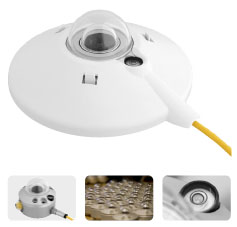 | |||
| Building a System |
| Albedometer |
| To calculate Albedo the incoming global radiation is measured by a pyranometer facing upward and the radiation reflected by the ground is measured by a pyranometer facing downward. CMA 6 and CMA 11 are integrated Albedometer versions of CMP 6 and CMP 11. Details can be found in our dedicated Albedometer brochure. |
| Ventilation Unit |
| CVF4 ventilation unit is designed for use with all CMP Series pyranometers (CMP 3 fits but ventilation is less eective). Ventilation helps to keep the dome clean and reduces infrared thermal osets by stabilization of the dome temperature. The two levels of heating can be used to remove raindrops, dew, frost and snow. |
| Sun Tracker |
| SOLYS 2 and 2AP sun trackers are all-weather reliable instruments used to accurately point a pyrheliometer at the sun for direct radiation measurements. When fitted with an optional shading assembly and a pyranometer they measure diuse radiation with no need for periodic manual adjustments. Adding a second pyranometer for the global radiation makes a high quality solar monitoring station. |
| Shadow Ring |
| The combination of a pyranometer and a CM 121 shadow ring oers a simple solution for measuring diuse radiation from the sky. The ring only requires simple adjustment every few days to ensure that the shadow covers the pyranometer dome completely as the sun moves across the sky. |
| Amplification |
| Pyranometers have low output signals in the mV range. AMPBOX converts this to the industrial standard 4 to 20 mA current loop signal and provides a defined output range in W/m². Amplification is advised for noisy environments, use with data acquisition equipment with high-level inputs, and for very long cables (> 100 m). For pyranometers with amplified analog and digital outputs, see our SMP series. |
| Data loggers |
| Kipp & Zonen has a range of high performance data logging and display products for use with CMP series pyranometers and our other solar radiometers. |
| Mounting |
| Kipp & Zonen oers mounting fixtures for horizontal, tilted and down looking pyranometers. CMF 1 is a small round plate with integral rod for mounting upward and/or downward facing pyranometers. CMB 1 is a mounting bracket for mounting a 12-20 mm rod to a mast, 22-60 mm pole or wall. The adjustable tilt CMP mounting kit allows for tilted mounting of the pyranometer with a 0° to 90° graduated scale for the zenith angle. |
| Glare Screen Kit |
| A downward facing pyranometer should not see any radiation coming from the hemisphere above or from the first 5° below the horizon. To prevent this, a glare screen kit is available for use with all CMP series pyranometers (except the CMP 3). |
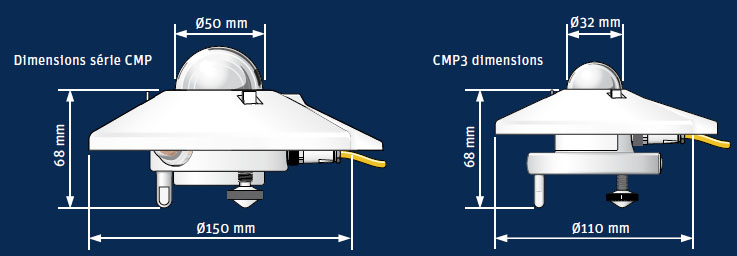
| Specifications | |||||
| CMP 3 | CMP 6 | CMP10 & CMP 11 | CMP 21 | CMP 22 | |
| Classification to ISO 9060:1990 | Second Class | First Class | Secondary Standard | Secondary Standard | Secondary Standard |
| Spectral range (50% points) | 300 to 2800nm | 285 to 2800nm | 285 to 2800nm | 285 to 2800nm | 200 to 3600nm |
| Sensitivity | 5 to 20V/W/m² | 5 to 20V/W/m² | 7 to 14V/W/m² | 7 to 14V/W/m² | 7 to 14V/W/m² |
| Impedance | 20 to 200 Ω | 20 to 200 Ω | 10 to 100 Ω | 10 to 100 Ω | 10 to 100 Ω |
| Expected output range (0 to 1500 W/m²) | 0 to 30mV | 0 to 30mV | 0 to 20mV | 0 to 20mV | 0 to 20mV |
| Maximum operational irradiance | 2000 W/m² | 2000 W/m² | 4000 W/m² | 4000 W/m² | 4000 W/m² |
| Response time (63%) Response time (95%) | < 6s < 18s | < 6s < 18s | < 1.7s < 5s | < 1.7s < 5s | < 1.7s < 5s |
| Zero osets (a) thermal radiation (at 200 W/m²) (b) temperature change (5 K/h) | < 15 W/m² < 5 W/m² | < 12 W/m² < 4 W/m² | < 7 W/m² < 2 W/m² | < 7 W/m² < 2 W/m² | < 3W/m² < 1W/m² |
| Non-stability (change/year) | < 1% | < 1% | < 0.5% | < 0.5% | < 0.5% |
| Non-linearity (100 to 1000 W/m²) | < 1.5% | < 1% | < 0.2% | < 0.2% | < 0.2% |
| Directional response (up to 80° with 1000 W/m² beam) | < 20 W/m² | < 20 W/m² | < 10 W/m² | < 10 W/m² | < 5 W/m² |
| Spectral selectivity (350 to 1500 nm) | < 3% | < 3% | < 3% | < 3% | < 3% |
| Temperature response | < 5% (-10°C to +40°C) | < 4% (-10°C to +40°C) | < 1% (-10°C to +40°C) | < 1% (-20°C to +50°C) | < 0.5% (-20°C to +50°C) |
| Tilt response (0° to 90° at 1000 W/m²) | < 1% | < 1% | < 0.2% | < 0.2% | < 0.2% |
| Field of view | 180° | 180° | 180° | 180° | 180° |
| Accuracy of bubble level | < 0.2° | < 0.1° | < 0.1° | < 0.1° | < 0.1° |
| Temperature sensor output | 10K Thermistor (optional Pt-100) | 10K Thermistor (optional Pt-100) | |||
| Detector type | Thermopile | Thermopile | Thermopile | Thermopile | Thermopile |
| Operational temperature range | -40°C to +80°C | -40°C to +80°C | -40°C to +80°C | -40°C to +80°C | -40°C to +80°C |
| Storage temperature range | -40°C to +80°C | -40°C to +80°C | -40°C to +80°C | -40°C to +80°C | -40°C to +80°C |
| Humidity range | 0 to 100% non-condensing | 0 to 100% non-condensing | 0 to 100% non-condensing | 0 to 100% non-condensing | 0 to 100% non-condensing |
| Ingress Protection (IP) rating | 67 | 67 | 67 | 67 | 67 |
| Recommended applications | Economical solution for routine measurements in weather stations, field testing | Good quality measurements for hydrology networks, greenhouse climate control | Meteorological networks, PV panel and thermal collector testing, materials testing | Meteorological networks, reference measurements in extreme climates, polar or arid | Scientific research requiring the highest level of measurement accuracy and reliability |
Note:
| |||||
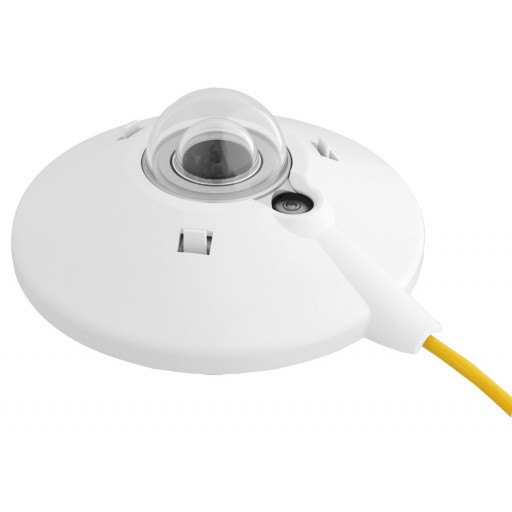

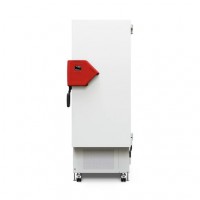



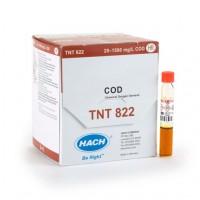
Do you have a question?
min 10 ch